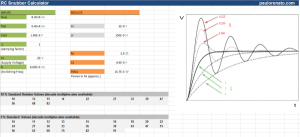
RC Snubber Calculator Spreadsheet
In power switching applications, a designer often has to contend with spurious oscillations. These are the result of parasitic capacitance and inductance on the board and behave like the step response of an RLC circuit. These transients can induced undesired noise in neighboring circuits and create over voltage spikes that can compromise long term component reliability.The most common way to mitigate the effects of these transients is by using an RC snubber circuit. There are many excellent sources on the web discussing this topic so I won’t repeat the discussion here (see references at the end for more information). Instead, I’m offering an Excel-based calculator that simplifies the components selection should you be faced with this task.
On the left side, colored in green, is the “inputs” section. In order to precisely “tune” the RC snubber, you should measure the frequency of the oscillations (without having the snubber) using an oscilloscope and enter it under fRING.
The next step is to add a know value test film capacitor in parallel with the MOSFET (CTEST) and measure the new oscillating frequency as a result. Finally, you must select the damping factor for the desired response depending on how much overshoot you can tolerate. There’s a graph in this document illustrating the normalized effect of the damping factor on the response.
The “results” section of the spreadsheet (colored orange) automatically calculate the recommended R and C values. The estimated parasitic capacitance CP and inductance LP are also displayed for reference. Power dissipated in the Rs resistor is also estimated using the maximum supply voltage (VS) and the maximum switching frequency (fS) so you can select a resistor with the appropriate power handling capability.
A table with standard E-series values is included for convenience.
For more detail: RC snubber calculator spreadsheet
